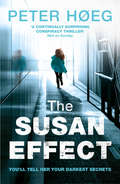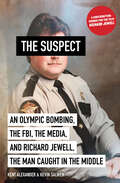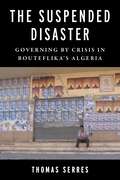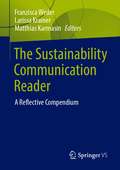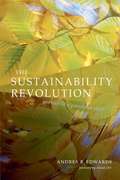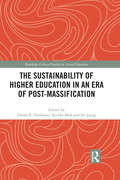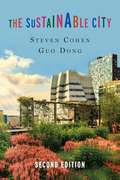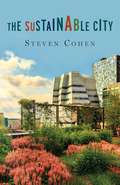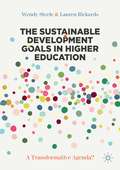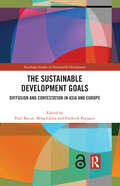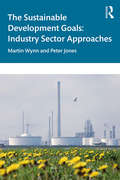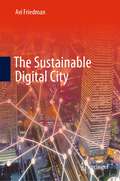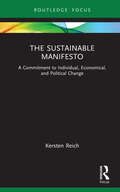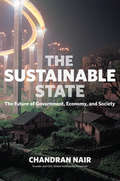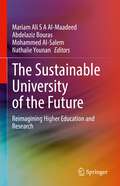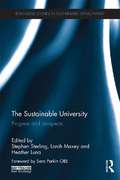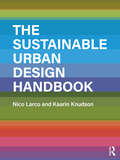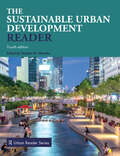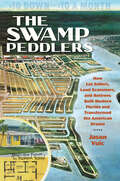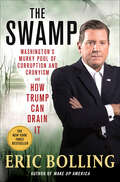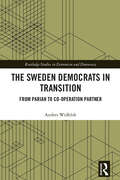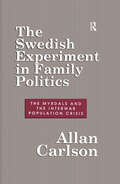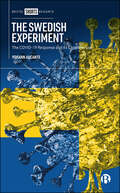- Table View
- List View
The Susan Effect
by Peter HøegYou'll tell her your darkest secretsSusan Svendsen has an unusual talent. She is an expert in finding out secrets. People feel compelled to confide in her and unwittingly confess their innermost thoughts. Her whole life, she has exploited this talent, but now her family is in jeopardy and there is a prison sentence hanging over her head.Then Susan gets a timely offer from a former government official: use her power one more time and have all charges dropped. But there are some powerful people determined to stop her.
The Suspect: An Olympic Bombing, the FBI, the Media, and Richard Jewell, the Man Caught in the Middle
by Kevin Salwen Kent AlexanderThe “intensively reported and fluidly written” true-crime account of the heroic security guard accused of the 1996 Centennial Olympic Park bombing (Wall Street Journal).On July 27, 1996, security guard Richard Jewell spotted a suspicious bag in Atlanta’s Centennial Olympic Park, the town square of the 1996 Summer Games. Inside was a bomb, the largest of its kind in FBI and ATF history. The bomb detonated amid a crowd of fifty thousand people. But thanks to Jewell, it only wounded 111 and killed two, not the untold scores who would have otherwise died. Yet seventy-two hours later, the FBI turned Jewell from a national hero into their main suspect. The decision not only changed Jewell’s life, it let the true bomber roam free to strike again. Today, most of what we remember of this tragedy is wrong.In a triumph of investigative journalism, former U.S. Attorney Kent Alexander and reporter Kevin Salwen reconstruct events before, during, and after the bombing. Drawn from law enforcement evidence and the extensive personal records of key players—including Richard himself—The Suspect, is a gripping story of domestic terrorism and an innocent man’s fight to clear his name.
The Suspended Disaster: Governing by Crisis in Bouteflika's Algeria (Columbia Studies in Middle East Politics)
by Thomas SerresAfter Algeria’s president Abdelaziz Bouteflika announced his intention to run for a fifth term in early 2019, a popular peaceful uprising erupted calling for change. Bouteflika, who had been in office since 1999, was eventually forced to resign, but the Hirak (“movement”) continued to protest the country’s inequalities and entrenched ruling elite.The Suspended Disaster examines the dynamics of the Algerian political system, offering new insights into the last years of Bouteflika’s rule and the factors that shaped the emergence of an unexpected social movement. Thomas Serres argues that the Algerian ruling coalition developed a mode of government based on the management of a seemingly never-ending crisis, marked by an obsession with security and the ever-present possibility of unrest, violence, and economic collapse. Identifying this form of rule as “governance by catastrophization,” he shows how attempts to preserve the status quo through emergency policies and constant reforms can also lay the groundwork for a revolutionary situation. Serres contrasts the government’s portrayal of perpetually imminent disaster with the uncertainty, precarity, and indignity experienced by much of the population, which fueled the rejection of ruling elites, a profound mistrust toward institutions, and new spaces for grassroots opposition.Based on extensive fieldwork and theoretically novel, The Suspended Disaster sheds new light on the political, economic, and social processes underlying an uprising that changed the face of Algerian politics.
The Sustainability Communication Reader: A Reflective Compendium
by Larissa Krainer Matthias Karmasin Franzisca WederThe Textbook seeks for an innovative approach to Sustainability Communication as transdisciplinary area of research. Following the United Nations Sustainable Development Goals, which are intended to transform the world as it is known, we seek for a multidisciplinary discussion of the role communication plays in realizing these goals. With complementing theoretical approaches and concepts, the book offers various perspectives on communication practices and strategies on an individual, organizational, institutional, as well as public level that contribute, enable (or hinder) sustainable development. Presented case studies show methodological as well as issue specific challenges in sustainability communication. Therefore, the book introduces and promotes innovative methods for this specific area of research.
The Sustainability Revolution: Portrait of a Paradigm Shift
by Andres R. EdwardsThis book analyzes the sustainability of the five major sectors of society - government, business, ecology, resources and conservation. It explains innovative projects and policies.
The Sustainability Revolution: Portrait of a Paradigm Shift
by Andres R. Edwards David W. OrrSustainability has become a buzzword in the last decade, but its full meaning is complex, emerging from a range of different sectors. <P><P>In practice, it has become the springboard for millions of individuals throughout the world who are forging the fastest and most profound social transformation of our time--the sustainability revolution. The Sustainability Revolution paints a picture of this largely unrecognized phenomenon from the point of view of five major sectors of society: Community (government and international institutions)Commerce (business)Resource extraction (forestry, farming, fisheries etc.)Ecological design (architecture, technology)Biosphere (conservation, biodiversity etc.) The book analyzes sustainability as defined by each of these sectors in terms of the principles, declarations and intentions that have emerged from conferences and publications, and which serve as guidelines for policy decisions and future activities. Common themes are then explored, including: An emphasis on stewardshipThe need for economic restructuring promoting no waste and equitable distributionAn understanding and respect for the principles of natureThe restoration of life formsAn intergenerational perspective on solutions Concluding that these themes in turn represent a new set of values that define this paradigm shift, The Sustainability Revolution describes innovative sustainable projects and policies in Colombia, Brazil, India and the Netherlands and examines future trends. Complete with a useful resources list, this is the first book of its kind and will appeal to business and government policymakers, academics and all interested in sustainability.
The Sustainability of Higher Education in an Era of Post-Massification (Routledge Critical Studies in Asian Education)
by Deane Neubauer Jin Jiang Ka MokThis volume examines the sustainability of higher education massification throughout the Asia Pacific region. The massification of higher education has swept across the region over the past three decades in complex and astounding ways in some cases. The book inquires after the many faces that higher education massification is taking in varied country settings and seeks to identify the more important implications that follow. It discusses massification and its sustainability within the region’s complex contexts and addresses the issues of implications, challenges, and limitations. Paying particular attention to implications on resources, employment and social mobility, institutional identity, programs, funding and teacher education, the book explores the capacity of countries to stay on the course they have chosen and the implications this may have for the continued identification of resources to do so, the choice to focus more particularly and importantly on the considerable range of innovations and variations and the ability to recognize and develop them in meaningful ways.
The Sustainable City
by Steven Cohen Dong GuoLiving sustainably is not just about preserving the wilderness or keeping nature pristine. The transition to a green economy depends on cities. Economic, technological, and cultural forces are moving people out of rural areas and into urban areas. If we are to avert climate catastrophe, we will need our cities to coexist with nature without destroying it. Urbanization holds the key to long-term sustainability, reducing per capita environmental impacts while improving economic prosperity and social inclusion for current and future generations.The Sustainable City provides a broad and engaging overview of the urban systems of the twenty-first century. It approaches urban sustainability from the perspectives of behavioral change, organizational management, and public policy, looking at case studies of existing legislation, programs, and public-private partnerships that strive to align modern urban life and sustainability. The book synthesizes the disparate strands of sustainable city planning in an approachable and applicable guide that highlights how these issues touch our lives on a daily basis, including the transportation we take, the public health systems that protect us, where our energy comes from, and what becomes of our food waste.This second edition of The Sustainable City dives deeper into the financing of sustainable infrastructure and initiatives and puts additional emphasis on the roles that individual citizens and varied stakeholders can play. It also reviews current trends in urban inequality and discusses whether a model of sustainability that embraces a multidimensional approach to development and a multistakeholder approach to decision making can foster social inclusion. It features many more examples and new international case studies spanning the globe.
The Sustainable City
by Steven CohenLiving sustainably is not just about preserving the wilderness or keeping nature pristine. The transition to a green economy depends on cities. For the first time in human history, the majority of the people on the planet live in urban areas. If we are to avert climate catastrophe, we will need our cities to coexist with nature without destroying it. Many places are already investing in the infrastructure of the future—including renewable energy, energy efficiency, mass and personal transit, and advanced sewage and waste management—but the modern city still has a long way to go.In The Sustainable City, Steven Cohen provides a broad and engaging overview of the urban systems of the twenty-first century, surveying policies and projects already under way in cities around the world and pointing to more ways progress can be made. Cohen discusses the sustainable city from an organizational-management and public-policy perspective that emphasizes the local level, looking at case studies of existing legislation, programs, and public-private partnerships that strive to align modern urban life and sustainability. From waste management in Beijing to energy infrastructure in Africa to public space in Washington, D.C., there are concrete examples of what we can do right now. Cohen synthesizes the disparate strands of sustainable city planning in an approachable and applicable guide that highlights how these issues touch our lives on a daily basis, whether the transportation we take, where our energy comes from, or what becomes of our food waste. Providing recommendations and insights with immediacy and relevance, this book has invaluable lessons for anyone seeking to link public policy to promoting a sustainable lifestyle.
The Sustainable Development Goals in Higher Education: A Transformative Agenda?
by Wendy Steele Lauren RickardsThis book explores the role universities have to play in fulfilling the Sustainable Development Goals (SDGs). At the heart of “sustainable development” is the legacy of unsustainable development with its roots in modernity and colonialism. Critical engagement with the SDGs involves recognising these roots are shared by universities and the reciprocal need for maintenance, repair and regeneration. Universities are not just enablers of change, but also important targets of change. By focusing on the role of education about, for and through the SDGs, the authors seek to advance critical engagement with higher education that is both progressive and meaningful. We are all responsible for bearing witness to our age. This book will appeal to all those who hope that more sustainable future worlds are still possible.
The Sustainable Development Goals: Diffusion and Contestation in Asia and Europe (Routledge Studies in Sustainable Development)
by Paul Bacon Frederik Ponjaert Mina ChibaThere have been significant efforts to implement the Sustainable Development Goals (SDGs) at multiple levels of governance across all regions of the world. However, the manner in which the global governance norms underlying the SDGs are actually being diffused is under-researched and not well understood. This book considers the promotion of the SDGs through the lens of norm diffusion theory, with a focus on three SDG policy areas; health, education and decent work. A distinctive feature of the book is that it offers multiple original case studies of SDG norm diffusion involving Asian and European actors. A unique feature is that the case studies in the book identify relevant SDG norm senders and norm receivers, and examine the relationship between them. The book also challenges the assumption that the SDGs themselves are static and unchanging, and reveals how SDG norms are dynamic and can be reformulated as a result of contestation between norm senders and norm receivers. As well as introducing a diverse and original set of case studies, the book therefore allows readers to deepen their understandings of the policy diffusion mechanisms by which SDGs are diffused, and grasp the patterns of success and failure in the implementation of these policies.
The Sustainable Development Goals: Industry Sector Approaches
by Peter Jones Martin WynnIn 2015, the United Nations launched the Sustainable Development Goals (SDGs) to define and coordinate global priorities and aspirations up to 2030 in response to the economic, social and environmental challenges faced by the planet. Many governments across the world signed up to these goals. United Nations Secretary-General Ban Ki-Moon noted at the outset that business would be a vital partner in achieving the SDGs. This easy-to-digest book provides a critical evaluation of how a range of multinational companies from across different commercial sectors are currently addressing the SDGs and the challenges they are facing in contributing to them. The private sector has thus been set the challenge of responding positively in support of the SDGs whilst at the same time acting in the shorter-term interests of its stakeholders. Using a wealth of illustrative materials drawn from company reports and other sources, this book looks at the response of 80 companies and organisations from eight different industry sectors. It examines the different approaches taken, discusses how far the SDGs are actively supported and reviews how progress is being assessed against related targets and objectives. In addition to an analysis of each industry sector, the book provides a summary overview of all industry sectors studied, identifying the most and least supported SDGs overall. This book will be of interest to the fast-growing body of academics studying and researching sustainability, as well as to industry managers and public-sector operators involved in sustainability management and reporting. It provides detailed commentary and insights, and identifies both key themes from the research and critical issues for the successful implementation of the SDGs in the period up to 2030.
The Sustainable Digital City
by Avi FriedmanThis book explores the rise of technology-centered urban planning and the diffusion of these practices around the world. Seven axes of urban planning have been selected to highlight how data and technology currently work and how these systems can be improved going forward. Each aspect is explored in its own chapter that combines narrative description, illustrations, and case studies to show how technology currently shapes our cities and how this may impact the urban environments. Topics include infrastructure, mobility, energy use and distribution, work, public health, and knowledge transfer among others. The book also demonstrates how these aspects are tied to and affect the four pillars of sustainability: environment, society, economy, and culture.
The Sustainable Manifesto: A Commitment to Individual, Economical, and Political Change (Routledge Focus on Environment and Sustainability)
by Kersten ReichIn The Sustainable Manifesto, Kersten Reich describes in a concise and memorable way the necessary actions that humans need to take to live sustainably and combat climate change. Are we sufficiently capable of changing our behaviour towards sustainability? What do we have to do in a more sustainable way, and how? The Sustainable Manifesto considers questions around behaviour-change and action for sustainability and connects this thinking to current research in both the natural and human sciences. Reich begins by addressing the most important risks to sustainability and looks in particular at climate change, biodiversity, land use and global phosphorus and nitrogen cycles. He goes on to identify the main causes that have led to the current crisis: specifically the human desire for expansion, growth in all areas, progress and competitive advantages that have forced consideration of the common good into the background. In this vein, the author highlights how economics and politics are two driving forces for which sustainability is difficult to comprehend, going against their basic principles of a liberal and now neo-liberal expansion of all markets. Finally, Reich demonstrates how sustainability could be possible if we reprioritize our life goals and face the reality of an ecological crisis and the necessary transformation of society in order to save our planet. Innovative and accessible, this book will be of interest to students and researchers of sustainability, theories of learning, human behaviour, as well as those who are looking for answers on how to fight for a sustainable future.
The Sustainable State: The Future of Government, Economy, and Society
by Chandran NairThe free-market, limited government development model has been an ecological and social disaster for the developing world. Sustainable and equitable development is only possible with the active involvement of a strong central state that can guide the economy, protect the environment, and prioritize meeting their people's basic needs. In this sure to be controversial book, Chandran Nair shows that the market-dominated model followed by the industrialized west is simply not scalable. The United States alone, with less than five percent of the world's population, consumes nearly a quarter of its resources. If countries in Asia, where 60% of the world's population lives, try to follow the Western lead, the results will be calamitous. .Instead, Nair argues that development must be directed by a state that is willing and able to intervene in the economy . Corporations, which by design demand ever-expanding consumption, need to be directed towards meeting societal needs or otherwise restrained, not unleashed. Development has to be oriented towards the greatest good—clean drinking water for the many has to take precedence over swimming pools for the few. He provides three compelling case studies demonstrating the benefits of such strong state governance and the findings of weak state governance.This will mean rethinking the meaning of concepts like "prosperity," "freedom," and "rights," and whether democracy is always the best way to ensure responsive government—as Nair writes, "A democracy that cannot work to improve the life of its citizens is not better than a non-democracy that can actually improve quality of life." Many people will find these to be challenging ideas, but what Nair offers is a model suited to the realities of the developing world, not the assumptions of the dominant culture.
The Sustainable University of the Future: Reimagining Higher Education and Research
by Abdelaziz Bouras Mariam Ali S A Al-Maadeed Mohammed Al-Salem Nathalie YounanThe Sustainable University of the Future discusses the rapid changes taking place within institutions of higher education—changes that have pushed universities to reconsider their traditional policies and plans. The book, which has its origins in the Qatar University Annual Research Forum and Exhibition (QUARFE) event “University of the Future” examines the many ways universities are trying to keep pace with this transformation, despite regional and international challenges. The book looks at the role of universities in meeting the United Nation's Sustainable Development Goals (SDGs), the impact of Industry 4.0, the social aspects of University 4.0, and the future of research-based universities. The need to adopt modern programs and tools is stressed, and ways to anticipate and plan for future challenges are explored.
The Sustainable University: Progress and prospects (Routledge Studies in Sustainable Development)
by Stephen Sterling Larch Maxey Heather LunaThe direction of higher education is at a crossroads against a background of mounting sustainability-related issues and uncertainties. This book seeks to inspire positive change in higher education by exploring the rich notion of the sustainable university and illustrating pathways through which its potential can be realised. Based on the experience of leading higher education institutions in the UK, the book outlines progress in the realisation of the concept of the ‘sustainable university’ appropriate to the socioeconomic and ecological conditions facing society and graduates. Written by leading exponents of sustainability and sustainability education, this book brings together examples, insight, reflection and strategies from the experience of ten universities, widely recognised as leaders in developing sustainability in higher education. The book thus draws on a wealth of experience to provide reflective critical analysis of barriers, achievements, strategies and potential. It critically reviews the theory and practice involved in developing the sustainable university in a systemic and whole institutional manner, including the role of organisational learning.While remaining mindful of the challenges of the current climate, The Sustainable University maps out new directions and lines of research as well as offering practical advice for researchers, students and professionals in the fields of management, leadership, organisational change, strategy and curriculum development who wish to take this work further.
The Sustainable Urban Design Handbook
by Nico Larco Kaarin KnudsonThe Sustainable Urban Design Handbook gathers the best sustainability practices and latest research from the fields of architecture, landscape architecture, planning, development, ecology, and environmental engineering and presents them in a graphically rich and accessible format that can help guide urban design decisions in cities of all sizes.The book presents a comprehensive framework that organizes more than 50 elements of sustainable urban design under five main topics–Energy Use & Greenhouse Gas, Water, Ecology & Habitat, Energy Use & Production, and Equity & Health–and relative to four project scales: Region & City, District & Neighborhood, Block & Street, and Project & Parcel. Each element chapter includes a summary of importance and background, compares typical practices and recommended approaches, explains connections to other elements, and concludes with urban design guidelines that can be used to directly inform projects and decisions.Easy to use and reference, The Sustainable Urban Design Handbook provides both an in-depth introduction to topics across sustainable urban design and serves as an on-going reference for anyone involved in the creation of sustainable urban environments. This resource will be useful to design and planning professionals, community members, students, and elected officials in guiding decisions about our sustainable future.
The Sustainable Urban Development Reader (Routledge Urban Reader Series)
by Stephen M. WheelerThis thoroughly revised and updated fourth edition of The Sustainable Urban Development Reader combines classic and contemporary readings to provide a broad introduction to the topic that is accessible to general and undergraduate audiences. The Reader begins by tracing the roots of the sustainable development concept in the nineteenth and twentieth centuries through classic readings. It then explores dimensions of urban sustainability, including land use and urban design, transportation, ecological planning and restoration, energy and materials use, economic development, social and environmental justice, and green architecture and building. Additional sections cover tools for sustainable development, sustainable development internationally, visions of sustainable community, and case studies from around the world. The Sustainable Urban Development Reader remains unique in presenting a broad array of sustainable city readings, each with a concise introduction placing it within the context of this evolving discourse. Presenting an authoritative overview of the field using original sources in a highly readable format, this book is a valuable resource for general readers as well as students and researchers in urban studies, environmental studies, the social sciences, and related fields.
The Swamp Peddlers: How Lot Sellers, Land Scammers, and Retirees Built Modern Florida and Transformed the American Dream
by Jason VuicFlorida has long been a beacon for retirees, but for many, the American dream of owning a home there was a fantasy. That changed in the 1950s, when the so-called "installment land sales industry" hawked billions of dollars of Florida residential property, sight unseen, to retiring northerners. For only $10 down and $10 a month, working-class pensioners could buy a piece of the Florida dream: a graded home site that would be waiting for them in a planned community when they were ready to build. The result was Cape Coral, Port St. Lucie, Deltona, Port Charlotte, Palm Coast, and Spring Hill, among many others—sprawling communities with no downtowns, little industry, and millions of residential lots. In The Swamp Peddlers, Jason Vuic tells the raucous tale of the sale of residential lots in postwar Florida. Initially selling cheap homes to retirees with disposable income, by the mid-1950s developers realized that they could make more money selling parcels of land on installment to their customers. These "swamp peddlers" completely transformed the landscape and demographics of Florida, devastating the state environmentally by felling forests, draining wetlands, digging canals, and chopping up at least one million acres into grid-like subdivisions crisscrossed by thousands of miles of roads. Generations of northerners moved to Florida cheaply, but at a huge price: high-pressure sales tactics begat fraud; poor urban planning begat sprawl; poorly-regulated development begat environmental destruction, culminating in the perfect storm of the 21st-century subprime mortgage crisis.
The Swamp: Washington's Murky Pool of Corruption and Cronyism and How Trump Can Drain It
by Eric BollingHow Donald Trump can clear up political misconduct and corruption from the New York Times–bestselling author of Wake Up America.When Washington D.C. was first built, it was on top of a swamp that had to be drained. Donald Trump says it’s time to drain it again.In The Swamp, bestselling author and Fox News Channel host Eric Bolling presents an infuriating, amusing, revealing, and outrageous history of American politics, past and present, Republican and Democrat. From national political scandals to tempests in a teapot that blew up; bribery, blackmail, bullying, and backroom deals that contradicted public policies; cronyism that cost taxpayers hundreds upon hundreds of millions of dollars; and personal conduct that can only be described as regrettable, The Swamp is a journey downriver through the bayous and marshes of Capitol Hill and Foggy Bottom.The presidential election of 2016 was ugly, but it exposed a political, media, industry, and elite establishment that desperately wanted to elect a politician who received millions of dollars from terror-funding states over a businessman willing to tell the corrupt or incompetent, “You’re fired.”The book concludes with a series of recommendations for President Trump: practical, hard-headed, and concise ways to drain the swamp and force Washington to be more transparent, more accountable, and more effective in how it serves those who have elected its politicians and pay the bills for their decisions.Last year President Trump declared Wake Up America to be a “huge” book; Eric Bolling’s second book is sure to build on that success. Entertaining and timely, The Swamp is the perfect book for today’s political climate.
The Swastika and Symbols of Hate: Extremist Iconography Today
by Steven Heller“Force[s] even the most sophisticated to rethink and rework their ideas of how images work in the world.” —School Library Journal This is a classic story, masterfully told, in a new, revised and expanded edition about how one graphic symbol can endure and influence life—for good and evil—for generations and never, even today, be redeemed. A nuanced examination of the most powerful symbol ever created, The Swastika and Symbols of Hate explores the rise and fall of the symbol, its mysteries, co-option, and misunderstandings. Readers will be fascinated by the twists and turns of the swastika’s fortunes, from its pre-Nazi spiritual-religious and benign commercial uses, to the Nazi appropriation and criminalization of the form, to its contemporary applications as both a racist, hate-filled logo and ignorantly hip identity. Once the mark of good fortune, during the twentieth century it was hijacked and perverted, twisted into the graphic embodiment of intolerance. If you want to know what the logo for hate looks like, go no further. The Nazi swastika is a visual obscenity and provokes deep emotions on all sides. The Nazis weaponized this design, first as a party emblem, then as a sign of national pride and, ultimately, as the trademark of Adolf Hitler’s unremitting malevolence in the name of national superiority. A skilled propagandist, Hitler and his accomplices understood how to stoke fear through mass media and through emblems, banners, and uniforms. Many contemporary hate marks are rooted in Nazi iconography both as serious homage and sarcastic digital bots and trolls. Given the increasing tolerance for supremacist intolerance tacitly and overtly shown by politicians the world over, this revised (and reconfigured) edition includes additional material on old and new hate logos as it examines graphic design’s role in far-right extremist ideology today.
The Sweden Democrats in Transition: From Pariah to Co-operation Partner (ISSN)
by Anders WidfeldtThis book explains how the Sweden Democrats (SD), a populist radical right party, has moved from the fringes into the mainstream of Swedish politics.SD has experienced rapid growth and success in Sweden in recent years. Following the 2022 elections, SD became an official support party to a right of centre minority coalition. The party has managed this sustained electoral growth since it entered parliament in 2010, despite having roots in right-wing extremism, including some links with fascism and nazism. For these reasons it was for many years isolated by other parties, and given an overwhelmingly negative treatment by the media. This book explores the position of SD in the electorate, the changing status of SD among Swedish voters, and how other parties interact with SD. The analysis sheds light on the route into the mainstream of a party without a reputational shield. The argument is that, although the route SD has taken is different, it is only a matter of time before SD will take the final steps into the Swedish political mainstream and reach a position comparable to those of the Danish People’s Party, the Finns Party or the Norwegian Progress Party.The text will be of interest to scholars and students of European politics, comparative politics and populism.
The Swedish Experiment in Family Politics: Myrdals and the Interwar Population Crises
by Allan C. CarlsonThis devastating account of the work of Gunnar and Alva Myrdal is a monumental case study in the uses and abuses of social science. It portrays how these two young scholars used the power of ideas to help engineer a new domestic order in Sweden. The book focuses on the Myrdals' unique fusion of socialism and feminism with nationalism and pro-nationalism in their joint 1934 book, Crisis in the Population Question turning the issue of Sweden's declining birthrate into "the most effective argument for a radical socialist remodeling of society." The author uses interviews with many of the figures involved and extensive archival research (including restricted materials held by Sweden's Social Democratic Party) to weave an uncommonly personal account of triumphant social engineering. The work of the Myrdals covered every major area of family policy and planning from a marriage loan program to maternity relief. Using theories and research of a then new science of demography, the Myrdals did not so much demonstrate the interpretation of facts and values as blue the distinction between them in order to insinuate ideological claims and policy mandates. Carlson provides careful historical documentation of social welfare and policy in Sweden, indicating the uneven path to the brave new "middle way." There was renewed emphasis on domesticity and traditionalism in the 1950s, and only in the 1980s was the Myrdal "revolution" truly completed. For Carlson that revolution was less a tribute to the Myrdals' perspicacity than to a concurrence of circumstances: weak and inconsistent data, confusion over cause and effect, and avoidance of controls in experimental settings. Swedish experiments in marriage and family yielded a variety of results: a triumph of feminism over socialism; of reason over tradition, central government over regionalism, urban multi-family dwellings over suburban single family models, the therapeutic over the moral; and finally the state over the family. Because the Swedish "model" is widely regarded and emulated, this critique is of immediate significance. It offers the general reader remarkable insight into the nature of Scandinavian social life; and to the specialist in demography, economy, and sociology, a perspective on how social science can become itself the problem rather than provide solutions in contemporary post-industrial life.Allan Carlson is president of the Rockford Institute, and a member of the National Commission on Children. He is the author of Family Questions: Reflections on the American Social Crisis.
The Swedish Experiment: The COVID-19 Response and its Controversies
by Yohann AucanteWith Sweden traditionally hailed as a social and economic model, it is no wonder that the Swedish response to the COVID-19 pandemic raised a lot of questions – and eyebrows – around the world. This short book explores Sweden’s unique response to the global pandemic and the strong wave of controversies it triggered. It helps to makes sense of the response by defining ‘a Swedish model’ that incorporates the country’s value system, underpinning its politics and administration in relation to, among other things, welfare, democracy, civil liberties and respect for expertise. The book also acts as a case study for understanding the moral and normative ways in which different national approaches to the pandemic have been compared.
